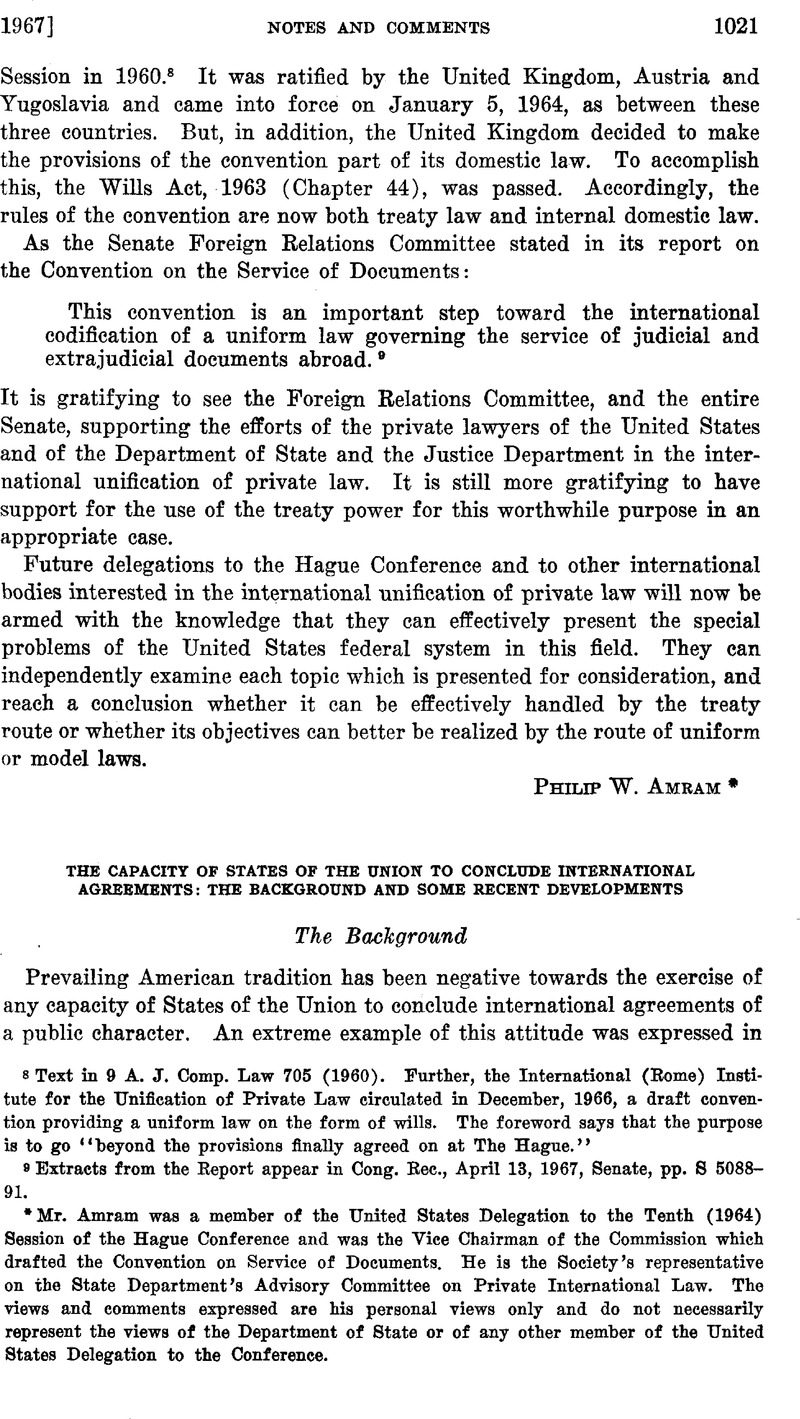Published online by Cambridge University Press: 28 March 2017

1 Chief of the Division of Latin American Affairs (Duggan) to J. M. Carson, Feb. 10, 1937, MS. Department of State, file 611.3731/1471. Cited in 5 Hackworth, Digest of International Law pp. 24-25 (1943). Concerning agreements entered into by States of the United States, see S. B. Crandall, Law of Treaties 141-145 (2nd ed., 1916); F. L. Zimmermann and Mitchell Wendell, The Interstate Compact since 1925, pp. 71-84 (1951). See also Zimmermann and Wendell, The Law and Use of Interstate Compacts (1961); Frankfurter and Landis, “The Compact Clause of the Constitution,” 34 Yale Law J. 685 (1925). Cf. 66 Stat. 71; 70 Stat. 701; 71 Stat. 367, 1701.
2 E. S. Corwin, The Constitution 82, 237 (1954).
3 See the grant of quasi-diplomatic privileges and immunities to certain officials of non-governmental organizations, Rodgers, “The Headquarters Agreement of the I.A.E.A., 39 Brit. Tr. Bk. Int. Law 391-395 (1958). See also Eodgers, Facilitation Problems of International Associations (1960).
4 Corwin, op. cit. 82.
5 Director of the Department of Motor Vehicles of the State of California (Ingels) to the Secretary of State (Hull), Aug. 15, 1936; the Legal Adviser of the Department of State (Hackworth) to Mr. Ingels, Aug. 26, 1938, MS. Department of State, file 811.79712/2. Cited in Hackworth, op. cit. above.
6 McHenry County et al. v. Brady, 37 N. Dak. 59, 163 N.W. 540 (1917).
7 148 U. S. 503, 518 (1893). See also Stearns v. Minnesota, 179 U. S. 223, 244 (1900).
8 The Constitution of the United States of America, 8. Doe. 232, 74th Cong., 2d Sess., pp. 366, 368 (Legislative Reference Service, Library of Congress). Substantially the same interpretation is upheld in The Constitution of the United States of America, S. Doc. 39, 88th Cong., 1st Sess., pp. 416-419 (1964).
9 Green v. Biddle, 8 Wheat. 1, 85 (1823).
10 Virginia v. Tennessee, 148 U. S. 503 (1893). “Virginia v. West Virginia, 11 Wall. 39 (1871). See also Dunbar, “Interstate Compacts and Congressional Consent,” 36 Va. Law Rev. 753 (1950).
12 Office of Commissioner of Puerto Rico, Washington, Documents on the Constitutional History of Puerto Rico passim (1964).
13 Act #37, H.B. 335.
14 In 1924 the Department of State, in reply to an inquiry, stated it had no information on the conclusion of any treaty or agreement between a State of the United States and a foreign government. The Under Secretary of State (Phillips) to H. H. Helble, March 26, 1924, MS. Department of State, file 711.00/96. Cited in Hackworth, op. cit. above. The policy of not noticing such agreements seems to continue to this date and the present author is unable to document agreements known to exist.
15 “Mexico and Six [sic] V. S. States,” 27-29, Port of Mobile, July, 1966. Published by the State Docks of Alabama, the director of which was present at the Biloxi conference.
16 Prelude to Progress. This booklet was issued after the conference. It consists of 54 pages but lacks date of publication or pagination. It appears to be issued in the name of the Director of the Mississippi Agricultural and Industrial Board.
17 ibaid. At one point in this booklet the Governor of Mississippi refers to the “close cooperation between the representatives of these Gulf South States and the representatives of the Republic of Mexico.” Following the adoption of the Declaration of Principles Lie. Aleman mentioned that “this is not a diplomatic treaty… . “
18 The author is not at liberty to cite official flies. There has been press coverage however: Le Soleil, Quebec, June 28, 1965.
19 Louisiana Tourist Development Commission, Minutes, March 7, 1967; Report of Meeting, March 28, 1967. The latter report, being a prècis, is somewhat inaccurate at points. Subsequent to the meeting a Memorandum, March 28, 1967, was circulated to Commission members explaining intended procedure and mentioning the possibility of negotiations with governments other than Quebec. Subsequent press releases of the Commission have referred to its Committee on International Accords, of which the writer is chairman. Cf. Letter, Governor of Louisiana to Prime Minister of Quebec, Aug. 15, 1967: “This is to affirm that Professor Raymond S. Rodgers, Ph.D., Aidede- Camp, Governor's Staff, is authorized to negotiate with your officials the text of the proposed Quebec-Louisiana Cultural Agreement. He is not to exceed the terms of the 25 May 1967 draft Agreement, which themselves reflect our Senate Concurrent Resolution 64 of 30 May 1967. Final conclusion of this negotiated Agreement will be by the Governor of Louisiana.“
20 See Gerald F. Fitzgerald, “Educational and Cultural Agreements and Ententes: France, Canada, and Quebec—Birth of a New Treaty-Making Technique for Federal States?”, 60 A.J.I.L. 529 (1966). See also Hugh Lawford, “Canadian Practice in International Law during 1964 as Keflected in Public Statements,” 4 Canadian yearbook of International Law 220-222 (1966); France-Quebec Educational Entente of Feb. 27, 1965, and an exchange of letters between the Canadian Secretary of State for External Affairs and the Chargé d'Affaires of France on that date, ibid,. 263-271.